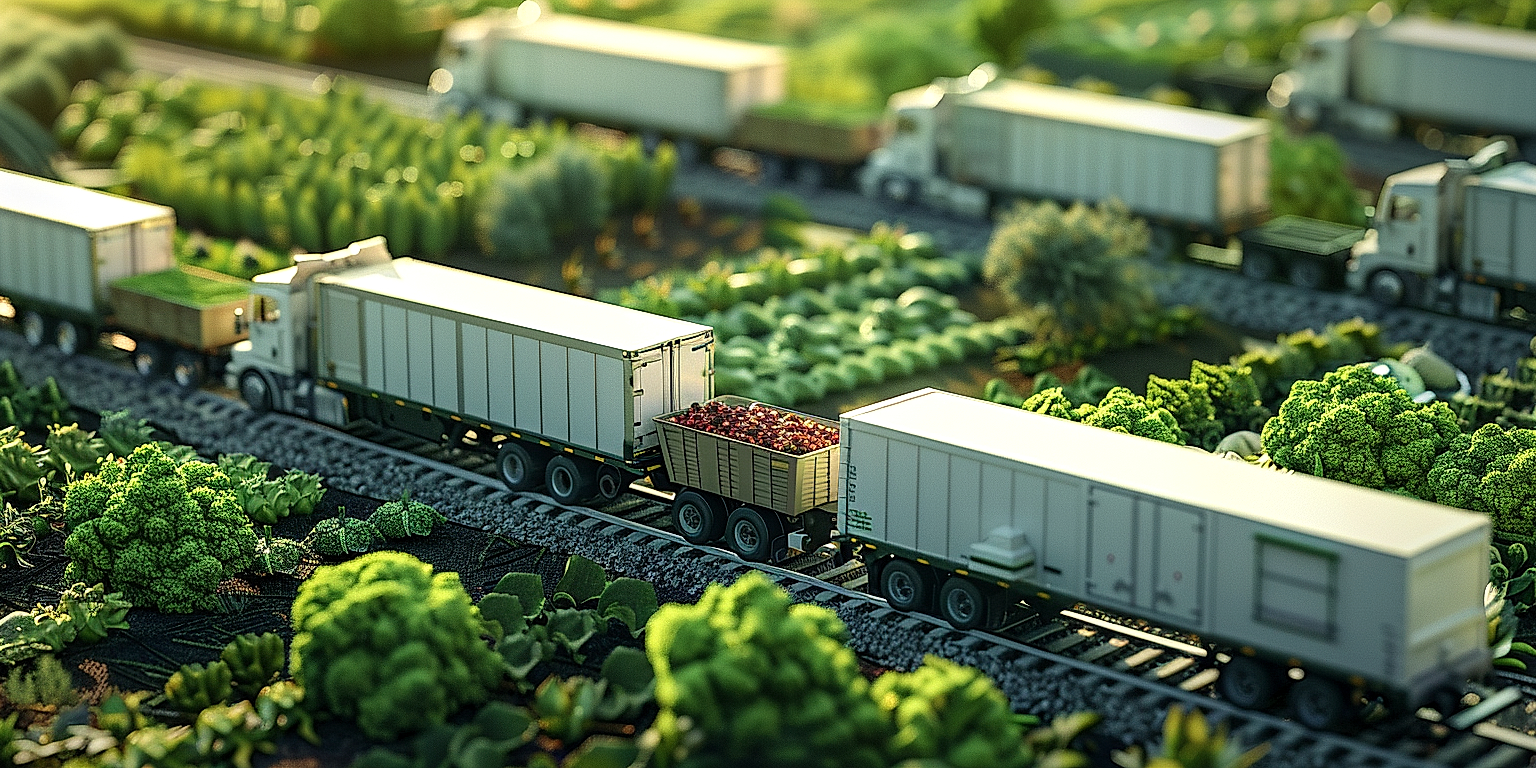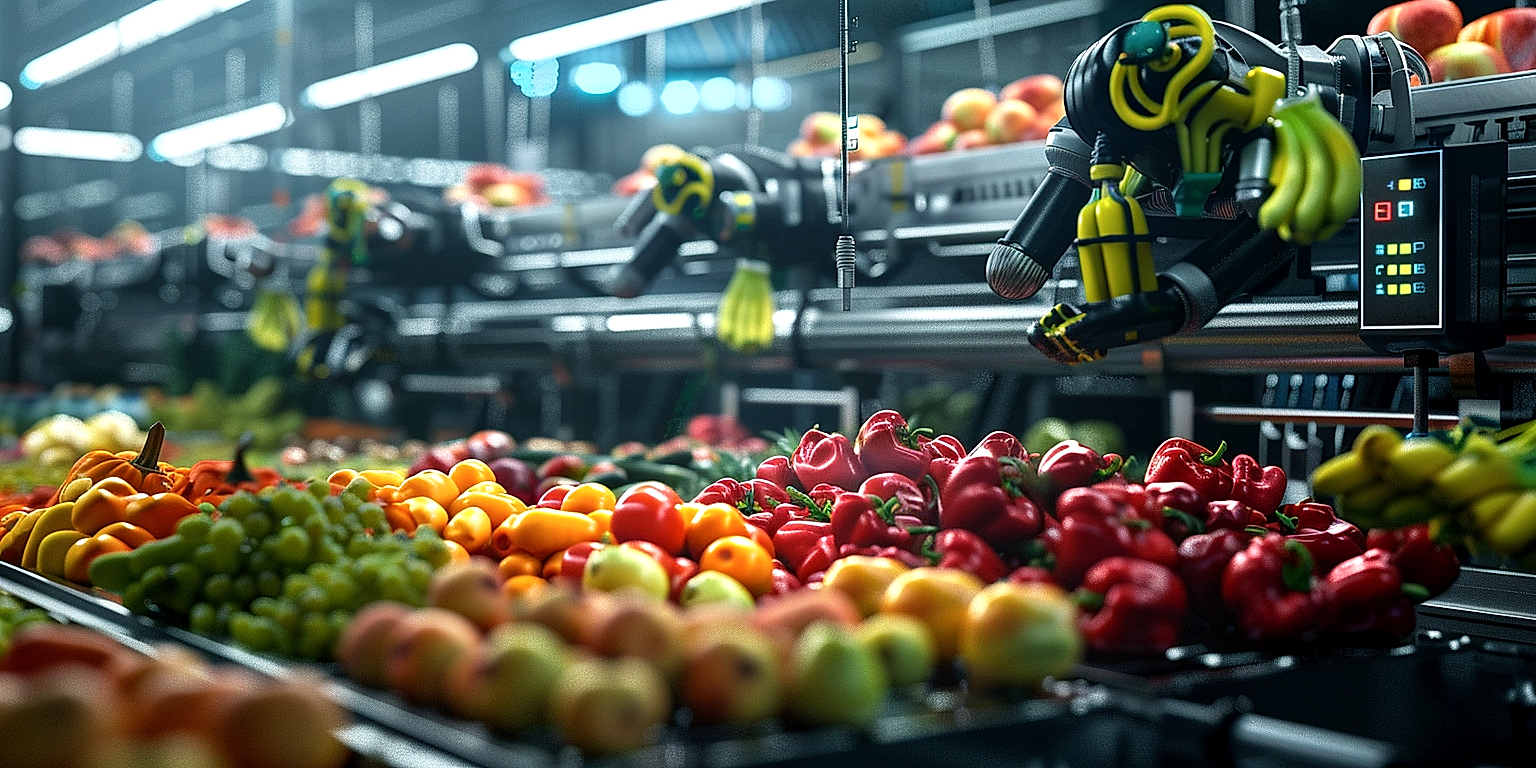Transportation forms a critical link in the supply chain for processed produce.
Optimal strategies can significantly impact not only cost-efficiency but also the freshness and quality of the product.
In a highly competitive market, it is crucial to minimize delays, reduce spoilage and ensure timely delivery.
This article seeks to elucidate some of the practical techniques and measures businesses can take to streamline their transportation process.
With rapidly evolving technologies and an increasingly global market, these strategies seek to harness the latest in logistical insights.
Together, we will explore how to structure a lean, responsive and efficient transportation system for processed produce.
Contents
- Efficient Transportation Strategies For Processed Produce
- 1. Use of Refrigerated Transportation
- 2. Regular Maintenance of Transport Vehicles
- 3. Utilizing rail for long-distance shipping
- 4. Combining loads for reduced trips
- 5. Employing Modern GPS Tracking Systems
- 6. Scheduling Off-Peak Delivery Times
- 7. Use of foldable/stackable crates for optimization
- 8. Implementing efficient route planning software
- 9. Use of Green, Sustainable Transportation
- 10. Regularly training drivers in efficiency tactics
- The Bottom Line
Efficient Transportation Strategies For Processed Produce
1. Use of Refrigerated Transportation
The use of refrigerated transportation for processed produce can significantly contribute to the efficiency of a supply chain.
These specialized transport vehicles, known as reefers, are designed to maintain products at specific, often refrigerated, temperatures.
They have a crucial role in the transportation of processed produce because these products often need controlled environments to maintain their quality and freshness.
Failure to effectively use refrigerator transport can lead to considerable food waste.
With adequate refrigeration during transport, the shelf life of produce can be significantly extended, meaning products reach their destination in optimal condition, therefore minimizing losses caused by spoilage.
Correct temperature management is vital during transportation; accurate temperature setting and continuous monitoring reduce the chances of the produce going bad.
What’s more, the use of high-quality refrigeration units helps to maintain controlled humidity levels, effectively limiting dehydration of vegetables and fruits.
Aside from preserving the quality of the produce, refrigerated transportation also increases the transportation distance feasible, allowing businesses to expand their geographical reach.
It also aids in ensuring the continuous supply of produce, which is crucial for meeting demand and maintaining business continuity.
When not in use, these refrigerator trucks can also double as temporary storage facilities, providing additional flexibility and efficiency during peak demand times.
However, the management of refrigerated transportation demands a certain level of expertise and planning.
For instance, keeping track of the fuel level and electricity supply to power the cooling system is essential for the successful shipment of goods.
The transport providers also need to follow strict hygiene standards to prevent contamination that could compromise the quality of the produce.
Despite these challenges, the use of refrigerated transportation is a key component in developing efficient transportation strategies for processed produce.
Moreover, continuous advancements in refrigeration technology, including developments in environmentally friendly refrigerants and energy-efficient models, further promote the adoption of this vital transport method.
2. Regular Maintenance of Transport Vehicles
Regular maintenance of transport vehicles is critical to ensuring the efficiency and reliability of the transportation process for processed produce.
This involves routinely checking and servicing the vehicle’s mechanical components to ensure they are functioning optimally.
Basic maintenance activities include changing the vehicle’s engine oil, checking the tire pressure, replacing worn-out tires, and tuning the engine.
A well-maintained vehicle is not only more fuel-efficient but also less likely to break down, ensuring the freshness and quality of the produce are maintained during transport.
Sudden breakdowns can cause delays and potentially lead to the spoiling of the produce, thereby resulting in significant financial losses.
Regular maintenance of transport vehicles minimizes the risk of unexpected breakdowns, leading to reduced downtime, fewer delays, and overall improvement in transportation efficiency.
Furthermore, keeping vehicles in top mechanical condition can extend their lifespan, which in turn, can lead to financial savings in the long term.
Preventive maintenance, which involves servicing the vehicle before a breakdown occurs, can help to identify potential issues that might need attention.
Utilizing a maintenance schedule, where the vehicle is serviced at regular intervals can help ensure that no key maintenance tasks are overlooked.
Maintenance records can also be useful in tracking the vehicle’s performance and identifying recurring issues.
Maintenance activities should not be limited to just the vehicle’s engine and mechanical parts, but should also include cleaning and sanitizing the interior of the vehicle, especially in the case of refrigerated trucks used for transporting produce.
Proper cleaning and sanitization can help prevent the growth of bacteria and other harmful microorganisms, which can cause spoilage or cross-contamination between batches of produce.
Finally, drivers should be trained to regularly inspect their vehicles before leaving for delivery, checking for any visible signs of wear and tear or potential mechanical issues.
This not only reduces the likelihood of on-the-road breakdowns, but also ensures that any problems are detected and addressed before they escalate into bigger, costlier issues.
Therefore, regular maintenance of transport vehicles plays an important role in maintaining the efficiency and effectiveness of transportation strategies for processed produce.
3. Utilizing rail for long-distance shipping
The use of rail transport for long-distance shipping is an efficient strategy for the movement of processed produce.
This transport method offers more cargo space and can accommodate larger amounts of goods compared to most road transport vehicles.
One major perk of using rail transport for shipping large quantities of produce is its ability to reduce overall shipping costs.
Rail transport not only enhances operational efficiency but it also plays a crucial role in minimizing environmental impact.
Since rail transport requires less energy per ton-mile than trucks, it results in lower emissions, helping businesses promote sustainable practices.
Using rail transport for long-distance shipping of processed produce is beneficial in terms of reducing traffic congestion, thus improving transportation efficiency.
Trains can operate during off-peak hours, and avoid the traffic and delays typically associated with road transport, thereby ensuring timely delivery of goods.
Moreover, rail transport provides a safer option for the transportation of processed produce, due to its lower risk of accidents in comparison to road transports.
Rail freight companies also employ sophisticated technology to track shipments and ensure they reach their destination on time and in optimal condition.
Additionally, damage to produce during long-distance transport is often lower in railways due to more stable conditions than road transport.
The procurement of rail transport services also provides the opportunity for businesses to negotiate long-term contracts, allowing for cost-effectiveness over an extended period.
Moreover, utilizing rail for long-distance shipping contributes to local, regional, and national economies by creating job opportunities in railway construction, management, and logistic services.
Further, shift from road transport to rail for long-distance shipping of processed produce can help reduce our reliance on fossil fuels, thereby contributing to the fight against climate change.
In conclusion, utilizing rail for long-distance shipping offers myriad benefits – it is an efficient, cost-effective, safe, environmentally friendly and can significantly improve the overall effectiveness of the transportation processes in the processed produce industry.
4. Combining loads for reduced trips
In the realm of processed produce transportation, a vital method to ensure efficiency is the practice of combining loads for reduced trips.
Often referred to as ‘Load Consolidation’, this strategy involves merging smaller loads into one larger load for simultaneous delivery, which can dramatically increase transportation efficiency and subsequently lower costs.
Load consolidation is beneficial for long and short distance deliveries, mitigating the number of trips taken thereby reducing fuel consumption and maximizing vehicle utilization.
Maintaining a high level of load volume per trip is crucial in ensuring operational efficiency and in lessening the environmental footprint.
Combining loads for reduced trips not only improves transport efficiency, but it also reduces delivery times, minimizes wear and tear on vehicles, and decreases the chances of product damage during transit.
Logistically, consolidating loads can require detailed planning and precise execution, to effectively combine and deliver products to multiple destinations without infringing on any time-sensitive restrictions.
It translates to a better-optimized delivery route, minimized idle time, and higher customer satisfaction due to more reliable delivery schedules.
Furthermore, this strategy can also bring about monetary savings through reduced fuel costs, lower insurance premiums due to fewer vehicles being on the road, and decreased vehicle maintenance expenses.
To effectively implement these combinations, it may necessitate an investment in advanced supply chain management technology which can automate and streamline the process.
The utilization of sophisticated route planning software and real-time tracking tools can aid in determining the most optimal routes and timings for combining loads, enhancing transport efficiencies significantly.
Combining loads for reduced trips can also strengthen the relationship between suppliers, producers, and retailers due to the increased level of collaboration and coordination the strategy can engender.
The strategy necessitates transparent communication and trust between all involved parties, as the consolidation of loads often involves multiple suppliers and/or customers.
Through implementing effective load consolidation, businesses can provide a more efficient, sustainable, and cost-effective solution for the transportation of processed produce.
The concept of combining loads for reduced trips acknowledges that efficiency in transportation is not solely about reducing costs, but also about improving customer service, reducing environmental impact, and promoting collaborative business relationships.
The strategy of combining loads to reduce trips presents an opportunity for businesses to not just be more efficient, but also to be more environmentally and socially responsible.
5. Employing Modern GPS Tracking Systems
The integration of modern GPS tracking systems is an effective strategy for enhancing the efficiency of transporting processed produce.
GPS technology enables real-time tracking of transport vehicles, providing valuable data about their locations at any given time.
Knowing the precise location of your transport vehicle at all times significantly enhances planning and decision-making processes.
This data is particularly useful when it comes to contingency planning, allowing managers to quickly reroute vehicles in the case of sudden changes or unexpected situations.
Modern GPS systems are also essential for optimizing routes.
By using advanced algorithms, these systems can identify the fastest and most fuel-efficient routes, resulting in significant cost and time savings.
Besides, with the use of GPS tracking, the possibility of transport vehicles getting lost or straying off route diminishes, therefore, increasing the efficiency and safety of the delivery process.
Modern GPS systems can also contribute to essential cost savings by monitoring the driving behavior of transport operators.
Through GPS tracking, companies can identify any instances of excessive speed, harsh braking, rapid acceleration, and unnecessary idling, all of which can increase fuel usage and vehicle wear-and-tear.
By addressing and correcting these behaviors, companies can ensure a more efficient and economical operation of their transportation fleet.
Reporting features provided by GPS systems can also come in handy.
They can provide crucial data on factors such as mileage, fuel usage, delivery times, and more, which can be analyzed to identify trends and opportunities for improvement.
Furthermore, GPS tracking can improve customer service levels by providing accurate delivery estimates to customers.
Knowing when their processed produce will arrive allows customers to better plan their operations, leading to enhanced customer satisfaction.
Overall, employing modern GPS tracking systems is a critical strategy in improving the efficiency of transported processed produce.
The benefits of this system contribute to multiple aspects of the transportation process, from route optimization and contingency planning to monitoring driver’s behavior and enhancing customer service.
6. Scheduling Off-Peak Delivery Times
In the realm of efficient transportation strategies for processed produce, scheduling off-peak delivery times holds significance.
Often overlooked, this approach offers numerous benefits to businesses, including cost optimization and improved transportation efficiency.
Off-peak hours refer to periods when traffic is less congested, often early mornings, late evenings, or overnight.
By planning deliveries during these times, companies can reduce the time spent in transit and subsequently lower fuel costs.
Moreover, off-peak delivery timing can help businesses avoid the hassle of navigating busy city traffic during rush hours, which can often delay delivery times and increase logistical complexities.
Also, fewer delays mean that the produce has a higher chance of reaching its destination in its freshest state, impacting positively on customer satisfaction.
It’s important to note that enabling off-peak deliveries may involve collaboration with local authorities and communities to avoid noise disruptions during quiet hours.
Vehicles equipped with quiet delivery technology can already enable off-peak deliveries in many urban areas with minimum public disturbance.
Furthermore, off-peak deliveries can reduce competition for unloading space in congested urban receiving areas such as supermarkets or restaurants.
Fewer vehicles simultaneously competing for this space during off-peak hours can vastly improve operational efficiency.
Besides efficiency, scheduling off-peak deliveries contributes to environmental sustainability.
When vehicles spend less time on the roads, it reduces their fuel consumption, which in turn leads to a decrease in harmful emissions.
Incorporating off-peak delivery times into existing transportation strategies requires an understanding of a region’s specific peak and off-peak periods, which can differ vastly depending on location and the nature of the business.
Not only should logistical considerations be analyzed, but businesses must also factor in the needs and preferences of their customers which are a key part of developing an efficient delivery schedule.
While there might be some initial challenges implementing changes to delivery scheduling, with proper planning and collaboration, shifting to off-peak deliveries can lead to valuable long-term advantages in the transportation of processed produce.
7. Use of foldable/stackable crates for optimization
Efficiency in transportation within the processed produce sector largely relies on the novel methods employed to store and transport the produce.
An emerging trend in this sector is the use of foldable/stackable crates for optimization.
These crates are designed in such a way that they can be folded when empty to take up less space, and stacked when full to efficiently utilize the carriage space.
This has the dual benefit of not only reducing the space required to store empty crates, but also increasing the amount of produce that can be transported per trip.
When considering transportation costs, this technique equates to significant cost reductions, leading to an overall reduction in the cost of the produce.
This strategy is even more attractive when considering the environmental impact of transportation.
By enabling more produce to be transported per trip, the total trips required and associated emissions are significantly reduced.
Furthermore, foldable/stackable crates are typically made from durable and recyclable materials, further enhancing their sustainability profile.
Optimization is not just about efficiency of space, but also about the ease of use and accessibility of produce.
The design of foldable/stackable crates takes into account the need for produce to be easily accessible during transportation and offloading.
By eliminating the need for disassembly and reassembly, these crates help to reduce the time spent on loading and unloading, further amplifying efficiency gains.
This technique is not without its challenges, however.
There are concerns around the durability and long-term use of these crates, as well as the upfront costs associated with acquiring them.
Despite these potential drawbacks, the use of foldable/stackable crates presents an innovative and efficient approach for transporting processed produce.
With careful consideration and planning, this strategy could revolutionize the processed produce transportation sector, contributing significantly to the ultimate goal of enhancing efficiency and sustainability.
8. Implementing efficient route planning software
Companies in the processed produce industry are increasingly recognizing the importance of implementing efficient route planning software.
This technology can significantly streamline operations, reducing costs related to transportation and optimizing productivity.
When dealing with perishable goods, timeliness is critical, and a poorly planned route can not only increase expenses but also result in the degradation of product quality.
The use of intelligent software can drastically enhance transportation routes, ensuring that produce is delivered in the most effective, timely manner.
These advanced tools are capable of incorporating various factors in real-time, such as traffic conditions, weather changes, driver schedules, and road restrictions, to generate the most efficient routes.
This optimizes fuel consumption, resulting in decreased operational costs, and aids in maximizing driver utilization.
Moreover, the implementation of route planning software goes beyond just creating optimal routes.
It also serves as an important tool for decision-making and strategic planning by providing important data and insights.
Live tracking enabled by such software allows for real-time monitoring of vehicle locations and provides updates on any unscheduled delays, enabling quick response to potential issues.
As a result, this leads to an improvement in customer service levels as clients can get real-time updates about their shipments and expected delivery times.
The application of this technology also promotes better execution of last-mile deliveries, a critical aspect in the processed produce industry.
This is due to the real-time adjustment of routes based on sudden changes in delivery requirements or unexpected challenges.
In addition, by using this software, companies can easily accommodate any specific customer requests or preferences, like preferred delivery times, without disturbing the efficiency of the overall route plan.
Moreover, some route planning software also has features for driver safety monitoring, providing alerts for irregular driving patterns or speeding.
This promotes a culture of safety within the company, reducing the possibility of accidents and enhancing overall company reputation.
Clearly, the implementation of efficient route planning software can bring about a significant transformation in the transportation strategies of processed produce companies, helping them to achieve their operational and customer service goals while also promoting sustainability.
9. Use of Green, Sustainable Transportation
The agriculture industry is becoming increasingly aware of the importance of environmentally responsible practices such as use of green, sustainable transportation in the transportation of processed produce.
Transitioning to cleaner and more sustainable transportation methods is not just a responsible thing to do for the environment but also can lead to significant cost savings and efficiency increases in the logistics of processed produce.
One of the primary strengths of using green transportation is the potential reduction of carbon footprints associated with transporting goods, which is extremely beneficial in mitigating the effects of climate change.
For instance, using electric trucks or hybrid vehicles, which release fewer harmful emissions into the atmosphere, can greatly contribute to an overall reduction in the carbon footprint of the transportation process.
Moreover, alternative fuels like biofuels and compressed natural gas could also be used in transportation, which can deliver a significant reduction in carbon emissions while also maintaining or even enhancing transport efficiency.
Such green and sustainable transportation methods are gradually being adopted more widely across the industry, even as technology continues to develop and make these methods more affordable and efficient.
It must not be forgotten that by adopting sustainable transportation methods, businesses are not only contributing positively to the environment but are also potentially enhancing their brand image in the eyes of increasingly environment-conscious consumers.
This can lead to increased customer retention and loyalty in the long run, ultimately benefitting both the bottom line and the planet.
Another advantage is that green, sustainable transport can often provide opportunities for government incentives or rebates which are designed to encourage environmentally friendly business practices.
These can include financial incentives, tax breaks or grants, which can offset the initial costs of transitioning to greener transportation methods.
It is also important to consider the long-term cost savings offered by green transportation. While the initial investment might be higher, the ongoing maintenance and fuel costs are often much lower, leading to long-term financial savings.
As technology continues to improve, green and sustainable transportation methods are becoming not just viable but often the most efficient and cost-effective option for transporting processed produce.
From electric trucks to biofuels, sustainable transportation has the potential to truly revolutionize the industry, making it environmentally friendly and cost-effective.
With ever-increasing awareness about climate change and the importance of sustainable practices, the transition to green transport is not a question of if, but when, making this topic imperative for any business involved in the processed produce industry.
As such, adopting sustainable transportation methods is no longer just an environmentally responsible decision but also a strategically significant one for businesses, a factor which will continue to drive this transition in the years to come.
10. Regularly training drivers in efficiency tactics
Ensuring optimal efficiency in the transportation of processed produce begins with investing in regular driver training.
This training focuses not only on driving skills, but more importantly, on awareness and understanding of efficiency tactics.
Drivers form a significant part of the transportation process, and as such, teaching them to incorporate consistent efficiency measures is crucial.
The importance of providing ongoing training to drivers cannot be understated, as it is a pivotal factor in improving the efficiency of the transportation process, ultimately leading to reduced operating costs and increased profit margins.
Issues such as fuel efficiency, route planning and on-time delivery can be addressed effectively with proper training.
The methods of driver training may include classroom-based instruction, virtual reality simulations, and on-the-job training.
Investing in regular, up-to-date training also ensures that drivers are well informed about the latest technologies and best practices in the transportation industry.
Regular driver training also helps in reducing instances of product damage caused by improper handling during transportation.
Moreover, efficient driving can significantly reduce fuel consumption, thereby reducing costs and environmental impact.
In addition to driving techniques, drivers should also be trained in the proper use of GPS and route planning software for optimal efficiency.
Training in handling different situations like traffic congestion, vehicle breakdowns and maintaining the quality of the produce even in adverse conditions is equally important for drivers involved in transporting processed produce.
Moreover, training can help drivers understand the value and importance of their role in contributing to company’s mission of sustainable and efficient operations.
Regularly evaluating the effectiveness of driver training and making necessary adjustments based on the results is an integral part of the process.
By doing so, companies can ensure that the training remains relevant and continues to bring about efficiency in the transportation process.
Since every company has different needs, the driver efficiency training program should be tailored to match the specific requirements of the business.
Thus, an investment in regular driver training is a proactive approach towards achieving greater efficiency in the transportation of processed produce.
The Bottom Line
Optimizing logistics operations requires a multifaceted approach.
Employing refrigerated transportation not only preserves product integrity but also reduces waste.
Regular maintenance of transport vehicles reduces breakdowns and the subsequent delays.
Long-distance shipping via rail proves to be a much more energy-efficient method while combining loads can significantly lower fuel consumption.
In the modern era, the adaptation of advanced GPS tracking systems and delivery scheduling during off-peak hours provides real-time control and reduces traffic congestion.
Additionally, clever usage of space through foldable/stackable crates can remarkably improve load efficiency.
Route planning software stands at the helm of ensuring faster and more efficient deliveries.
Moving towards green, sustainable methods of transportation is not only beneficial for the environment but also portrays a company’s commitment to social responsibility.
Regular training of drivers in efficiency tactics is a key step in achieving optimal results.
Ultimately, companies that adopt these strategies will distinguish themselves within highly competitive industries and will significantly improve their overall performance and profitability.




